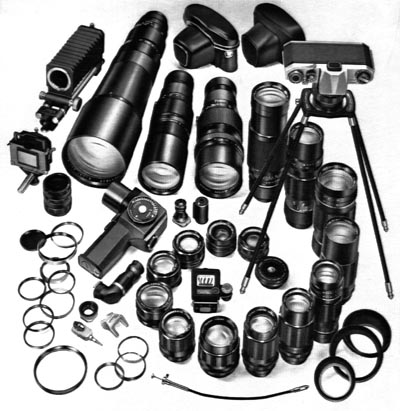Mount and Operation of Takumar Lenses
Asahi-Kogaku Takumar lenses: the exclusive fitting of Asahiflex
The choice of the screw fitting for Asahiflex system is due to its simpleness and consequent low cost, together with its functional character, perfectly adequate to the kind of gear Asahi Optical Co. was intended to manufacture. In early postwar time the only universal lens fitting was the Leica M39 screw, adopted by rangefinder cameras, without mirror box. You could count 35mm SLRs on one hand fingers and each manufacturer had a fitting of their own, Praktiflex’s M42x1 included. Asahiflex I (1952) introduced an exclusive M37x1 screwthread mount, hardly to understand being too small for next development of a complete lens system. On the technical side there is little to explain, being Asahiflex screw only devoted to mechanical connection between the body and the lens. Asahiflex lenses, compact and completely made by chrome finished brass (with the only exception of the 500mm telephoto) were called Asahi-Kogaku Takumars. Each lens adopted a different filter diameter. The very early f/3.5 50mm standard lens and the 500mm telephoto had a manual diaphragm ring, all others were of the pre-set type: a control ring let a certain aperture value to be selected following the rule of 16, the photographer’s experience or an external exposure meter reading; another ring, coupled to the diaphragm, let the iris to be fully opened for focussing and then closed the to the pre-selected value before taking each photo. Of course when you forget this last operation an overexposure will result. Due to the find of a few Asahiflex cameras with M42x1 screwmount somebody supposed the very late Asahiflexes were produced with the new fitting. AOC officially denied such an occurrence. It is then believed those hybrids are the result of ‘transplants’ made by repairers and possible because of the dimensions of the front panels and the positions of the four locking screws, same on all Asahiflex and Pentax models.
Asahi Optical Takumars: change to M42x1
Quite a complete system of lenses and accessories for the Asahiflex was introduced in a few years with good diffusion in USA. In spite of this, the Asahiflex fitting didn’t achieve a worldwide success, e.g. comparable to that of the well established Exakta bayonet (which suffered of the same small diameter limitations), so changing the lens fitting for the next generation of Pentax cameras was not a big shock. With the introduction of Asahi Pentax (1957), the exclusive fitting was abandoned together with the change to a wider mount and a yet diffused mount was adopted. It was the M42x1 screw of the contemporary Contax F/Pentacon F. This permitted full interchange of camera bodies and lenses between the yet diffused Pentacon system and the growing Pentax system. Takumar lenses of the Pentax series were faster and more impressive compared to their counterparts of the Asahiflex era. Finish became black with chrome finished diaphragm and focusing rings and filter threads were standardized to 46mm on all standard lenses. Speaking of linkage between the body and the lenses the only change is in the different screw, because also Asahi Optical Takumars are of the pre-set type, still needing no special connection.
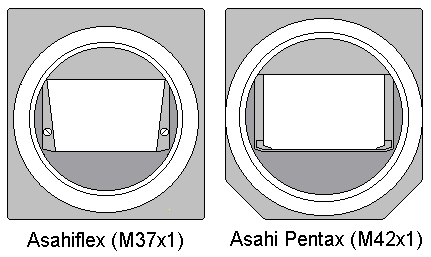
Auto-Takumars: automatic diaphragm operating
Asahi Pentax K (1958) also introduced a new f/1.8 55mm standard lens named Auto-Takumar. It was black + chrome finished with a black + chrome focusing ring similar to Meyer, Schneider and Zeiss Jena lenses of that era. The filter thread still remained of 46mm. The 1.8/55 Auto-Takumar lens introduced a new generation of lenses where the diaphragm stops down operated by the release button of the camera. A lever on the upper side of the lens allows the diaphragm to be opened after an exposure has been taken, while contemporarily loads a spring. An instant before the shutter releases, a plate assembly inside the mirror box pushes a pin into the lower side of the lens, releasing the spring and stopping down the iris to the pre-selected value. The optimistic definition "automatic lens" really means "manual opening and automatic closing lens".
Auto-Takumar f/1.8 55mm: fully automatic diaphragm
Together with Asahi Pentax S3 (1960) a new f/1.8 55mm lens was introduced. In spite of bearing the name Auto-Takumar like its predecessor it anticipates almost completely the next Super-Takumar lenses. The A/M (auto/manual) selector appeared for the first time on an Asahi lens, this being the last Pentacon guided technical evolution at Pentax. On M (manual) position the diaphragm ring directly operates the iris stopping it at the selected value: this allows proper operation with all early screwmount SLRs, unarranged for diaphragm automated operation. On A (auto) position the spring inside the lens (not to be loaded manually) usually keeps the diaphragm at full aperture, while the pin driven by the plate assembly stops down the iris to the selected value during exposure. This operation was first introduced the year before by Pentacon with their Praktina IIA. The auto operation is complete both in closing (by striking assembly inside the mirror box) and reopening (by spring loaded device inside the lens), freeing the user from a time loosing action that could be forgotten leading to wrong exposure. Gone the pre-set ring, all black finished, and with the now familiar 49mm filter thread the Auto-Takumar 1.8/55mm sports the ultimate look of a classic screwmount AOC lens. Both the focusing and the diaphragm rings turn contrary in comparison with East-German lenses. Within the S3 lens mount the striking assembly is different shaped compared to previous cameras (see figure). This assembly will be often modified on next models too.
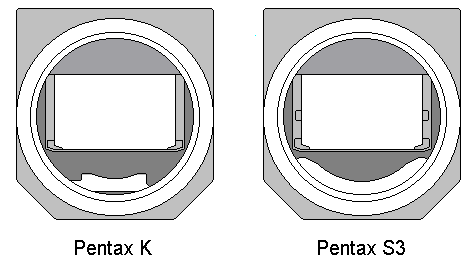
Super-Takumar lenses: the eyes of Spotmatic
With the introduction of SV (1962) and S1a (1963), slightly modified versions of S3 and S1, their 1.8/55 and 2/55 standard lenses changed their names to Super-Takumar, while their working remains almost the same as for the Auto-Takumar described above (see page 9, figure 3). There is only a curious change: for some mysterious reason the operation of the diaphragm ring was reversed, with slower f/stops to the left when looking from above with camera and lens hung at your neck. Around 1963 a late series of SV and S1a was introduced with modified mirror box in order to fit the next bulkier f/1.4 50mm Super-Takumar standard lens of the Spotmatic. The improvement was made around S/N. 650.000 for S1a and 725.000 for SV. This incidentally let us know Asahi Opt. Co. was manufacturing batches of different camera models with assigned serial numbers, on the contrary of early models which were all in the same figure sequence. In order to distinguish between these different series to avoid breakdowns when fitting new lenses to old cameras, the R marking on the rewind crank changed from green to orange. There are doubts about this rule has always been followed by AOC, so some caution is needed before fitting the f/1.4/50mm Super-Takumar to these models. All of Super-Takumar lenses properly work with the next Spotmatic (1964) and its revolutionary TTLTTL
acronym of "Through The Lens" metering system. However the stop-down metering requires the diaphragm to be stopped down for exposure reading after proper focusing has been achieved at full aperture. When working with the lens selector on Auto, you obtain instant diaphragm reopening after the picture has been taken. The filter thread still remains of standardized 49mm.
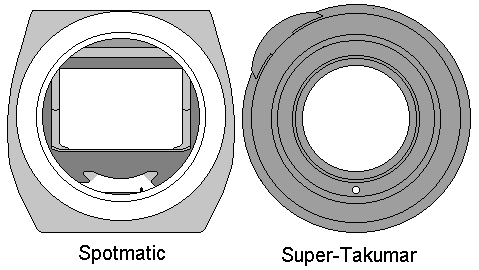
Super-Multi-Coated Takumars: open aperture metering
Together with the introduction of the Spotmatic II (1971), the world’s first anti-reflective multilayer coated lenses were introduced on the market. Apart from this important feature, a large amount of mechanical improvements were also introduced, arranging such lenses for open-aperture working with the next Electro Spotmatic and Spotmatic F cameras.
The action is logically based upon a device able to let the lens work at full aperture during light measurement while keeping the meter informed about how many f/stops the diaphragm will be closed next: such a device is called diaphragm simulating system. The simulating device of the camera is made by two coupler levers mounted on a twin rotating ring inside the body lens mount. The smaller lever on the left, as seen from outside the body mount, is engaged by a fixed tooth on the lens back and leads the simulating device to its working position. The upper lever inside the body mount is driven by a diaphragm coupled lever protruding from the lens, depending on the chosen aperture. The angle between the levers varies as aperture ring turns, keeping the meter informed. At full aperture the diaphragm coupled lever sticks in a given position, no matter what the aperture value is, then it turns as diaphragm ring is adjusted to inform the camera meter about how many f/stops will close at taking aperture. In other words the lens ‘calculates’ the aperture difference between full aperture and taking aperture and transmits this information to the camera, unaware of single data from which the difference has been calculated. Because the coupling device inside the body mount adapts to the lens tooth, the diaphragm simulation always works properly giving a correct exposure, no matter how the lens has been tightened. This guarantees a precise diaphragm simulation offering a correct meter reading at full aperture. When fitted to new cameras provided with a groove in the camera lens flange the near invisible A/M (Auto/Manual) locking pin on Super-Multi-Coated Takumars (not to be confused with the larger diaphragm release pin) locks the lens in AUTO position. On older cameras that A/M locking pin is kept depressed by flat body mount, allowing AUTO/MANUAL switching the same way as Super-Takumars. To complete this survey of the body lens mount you can notice that the diaphragm actuator plate, already modified in both shape and kinematic mechanism during evolution of the previous Pentax models, ‘slimmed’ again and turned from hinged to translatory motion toward the lens. The new lenses are cosmetically unchanged: only a less yellowish toning of the glass due to different coating and the Super-Multi-Coated markings on the frontal ring reveal some difference in comparison to old Super-Takumars without unfitting a lens from the camera to check its rear side.
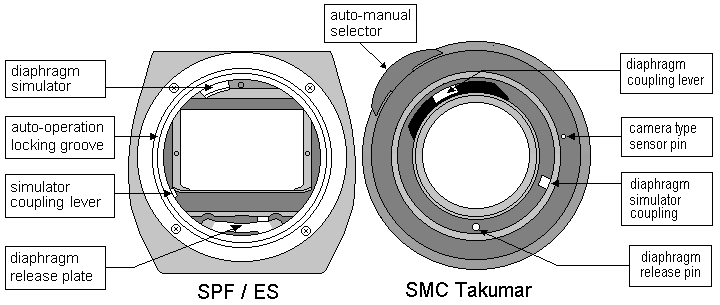
SMC Takumars: cosmetic variations only
In 1972 the standard lenses introduce cosmetic changes to match the style of that era: finish changed from traditional all-metal to modern square rubberised focusing ring. Extended Super-Multi-Coated Takumar name was shortened to SMC Takumar. Only standard lenses, together with newly introduced optics like the 100mm Macro lens and a few zoom lenses were converted to the new finish. No changes about lens working, in fact Asahi Optical themselves use the SMC designation for both old and new style lenses. From the collecting point of view a distinction is needed because of different cosmetics; also the matching of "SMC=modern look" is not always true. Maybe a collectors’ designation (e.g. SMC type I and type II) to distinguish different series could be welcome.
Summing up: lens diaphragm and how they operate
Manual lenses are named Takumars, and contain but one detent diaphragm ring which must be opened and closed manually and visually checked for correct setting.
Pre-set lenses are usually named Takumars or Tele-Takumars, and contain two adiacent diaphragm rings, each containing markings for the various lens apertures. One of the rings is of the detent type, while the other rotates freely. The detent ring is used to select the proper opening before exposure. The rotating ring is then turned to the lens widest aperture and the picture is composed and focused. Before the shutter is released, the rotating diaphragm ring is turned in the opposite direction to stop down the diaphragm to the value selected by the detent ring. The exposure is then made, and the rotating ring manually turned once again to open the diaphragm for composing and focusing the next picture.
Semi-automatic lenses are known as Auto-Takumars, and contain a diaphragm which has to be cocked manually and stops down automatically to a predetermined f/stop at the time of exposure. At the rear of the lens is a diaphragm cocking lever. Cocking the lever opens the diaphragm to its widest aperture and renders the subject image bright for composition and focusing. Assuming that you wish to make your picture at an aperture of f/8, the detent or click stop aperture ring is set at this f/stop, and when the shutter is released, the lens diaphragm automatically stops down to f/8.
Automatic lenses are known as Super-Takumars or Super-Multi-Coated Takumars after Asahi Opt. Co. introduced their exclusive Pentax 7-layer anti-reflective coating. A fully automatic diaphragm stops down to a preselected aperture when the shutter is released, then opens instantly to full aperture after the exposure is completed.
Early types of 55mm f/1.8 and f/2 equipped with automatic diaphragm feature a diaphragm ring which stops down by turning it counterclockwise when you hold the camera at eye level. In late type 55mm lenses, and all other Super-Takumars, the diaphragm ring stops down clockwise.
Super-Multi-Coated Takumar lenses are also equipped with a diaphragm simulator which informs the camera meter about how many f/stops the lens will stop down for exposure. This allows full aperture metering with late Asahi Pentax screw mount camera models.
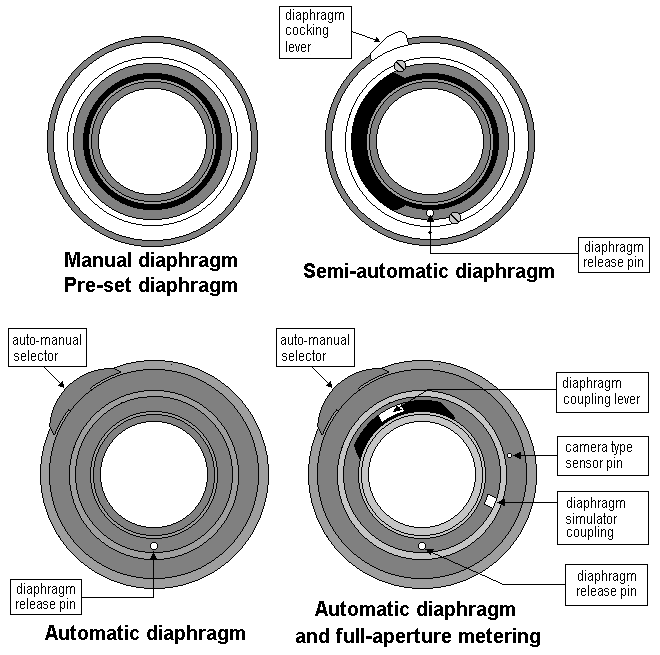
Text and images are Copyright © 1996-2000 by Dario Bonazza
- K-3 III Monochrome
2024-03-03
- 25° Pentax Day at ARENZANO il 5 maggio !
2024-03-03
- 24° PENTAX-DAY at PARMA on 25 June!
2023-06-19
Articles | About us | Pentax Day |
Vintage pictures | Batteries | Info Post |
Magazine | Books | Prototypes |
FAQ | Reflex | Screw M. Lenses |
Catalog | Search | CD-ROM |
Pentax Star System |
C.F.: 92085200399
Visite: 1232






